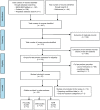Association between coffee or caffeine consumption and fecundity and fertility: a systematic review and dose-response meta-analysis
- PMID: 29276412
- PMCID: PMC5733907
- DOI: 10.2147/CLEP.S146496
Association between coffee or caffeine consumption and fecundity and fertility: a systematic review and dose-response meta-analysis
Abstract
Objective: The aim was to investigate whether coffee or caffeine consumption is associated with reproductive endpoints among women with natural fertility (ie, time to pregnancy [TTP] and spontaneous abortion [SAB]) and among women in fertility treatment (ie, clinical pregnancy rate or live birth rate).
Design: This study was a systematic review and dose-response meta-analysis including data from case-control and cohort studies.
Methods: An extensive literature search was conducted in MEDLINE and Embase, with no time and language restrictions. Also, reference lists were searched manually. Two independent reviewers assessed the manuscript quality using the Newcastle-Ottawa Scale (NOS). A two-stage dose-response meta-analysis was applied to assess a potential association between coffee/caffeine consumption and the outcomes: TTP, SAB, clinical pregnancy, and live birth. Heterogeneity between studies was assessed using Cochrane Q-test and I2 statistics. Publication bias was assessed using Egger's regression test.
Results: The pooled results showed that coffee/caffeine consumption is associated with a significantly increased risk of SAB for 300 mg caffeine/day (relative risk [RR]: 1.37, 95% confidence interval [95% CI]: 1.19; 1.57) and for 600 mg caffeine/day (RR: 2.32, 95% CI: 1.62; 3.31). No association was found between coffee/caffeine consumption and outcomes of fertility treatment (based on two studies). No clear association was found between exposure to coffee/caffeine and natural fertility as measured by fecundability odds ratio (based on three studies) or waiting TTP (based on two studies).
Conclusion: Results from this meta-analysis support the growing evidence of an association between coffee/caffeine intake and the risk of SAB. However, viewing the reproductive capacity in a broader perspective, there seems to be little, if any, association between coffee/caffeine consumption and fecundity. In general, results from this study are supportive of a precautionary principle advised by health organizations such as European Food Safety Authority (EFSA) and World Health Organization (WHO), although the advised limit of a maximum of two to three cups of coffee/200-300 mg caffeine per day may be too high.
Keywords: assisted reproduction; caffeine; coffee; fecundity; fertility; spontaneous abortion.
Conflict of interest statement
Disclosure The authors report no conflicts of interest in this work.
Figures


Similar articles
-
Caffeine intake and fecundability: a follow-up study among 430 Danish couples planning their first pregnancy.Reprod Toxicol. 1998 May-Jun;12(3):289-95. doi: 10.1016/s0890-6238(98)00002-1. Reprod Toxicol. 1998. PMID: 9628552 Clinical Trial.
-
A meta-analysis of risk of pregnancy loss and caffeine and coffee consumption during pregnancy.Int J Gynaecol Obstet. 2015 Aug;130(2):116-22. doi: 10.1016/j.ijgo.2015.03.033. Epub 2015 May 14. Int J Gynaecol Obstet. 2015. PMID: 26026343 Review.
-
Relationship between maternal caffeine and coffee intake and pregnancy loss: A grading of recommendations assessment, development, and evaluation-assessed, dose-response meta-analysis of observational studies.Front Nutr. 2022 Aug 9;9:886224. doi: 10.3389/fnut.2022.886224. eCollection 2022. Front Nutr. 2022. PMID: 36017225 Free PMC article.
-
Pre-pregnancy caffeine and caffeinated beverage intake and risk of spontaneous abortion.Eur J Nutr. 2018 Feb;57(1):107-117. doi: 10.1007/s00394-016-1301-2. Epub 2016 Aug 29. Eur J Nutr. 2018. PMID: 27573467 Free PMC article.
-
Coffee consumption and caffeine intake in relation to risk of fractures: a systematic review and dose-response meta-analysis of observational studies.Crit Rev Food Sci Nutr. 2023;63(28):9039-9051. doi: 10.1080/10408398.2022.2067114. Epub 2022 Apr 27. Crit Rev Food Sci Nutr. 2023. PMID: 35475944
Cited by
-
Maternal alcohol consumption and the risk of miscarriage in the first and second trimesters: A systematic review and dose-response meta-analysis.Acta Obstet Gynecol Scand. 2023 Jul;102(7):821-832. doi: 10.1111/aogs.14566. Epub 2023 May 23. Acta Obstet Gynecol Scand. 2023. PMID: 37221907 Free PMC article.
-
Can Nutrition Help in the Treatment of Infertility?Prev Nutr Food Sci. 2021 Jun 30;26(2):109-120. doi: 10.3746/pnf.2021.26.2.109. Prev Nutr Food Sci. 2021. PMID: 34316476 Free PMC article. Review.
-
The current situation and future directions for the study on time-to-pregnancy: a scoping review.Reprod Health. 2022 Jun 25;19(1):150. doi: 10.1186/s12978-022-01450-6. Reprod Health. 2022. PMID: 35752834 Free PMC article.
-
Diagnosis and management of infertility: NICE-adapted guidelines from the Italian Society of Human Reproduction.Reprod Biol Endocrinol. 2024 Jan 5;22(1):9. doi: 10.1186/s12958-023-01179-2. Reprod Biol Endocrinol. 2024. PMID: 38183116 Free PMC article.
-
Development of a nutrition screening tool to identify need for dietetic intervention in female infertility.J Hum Nutr Diet. 2023 Feb;36(1):154-168. doi: 10.1111/jhn.13055. Epub 2022 Jul 24. J Hum Nutr Diet. 2023. PMID: 35762584 Free PMC article. Review.
References
-
- Juul S, Karmaus W, Olsen J. Regional differences in waiting time to pregnancy: pregnancy-based surveys from Denmark, France, Germany, Italy and Sweden. The European Infertility and Subfecundity Study Group. Hum Reprod. 1999;14(5):1250–1254. - PubMed
-
- Schmidt L. Infertility and assisted reproduction in Denmark. Epidemiology and psychosocial consequences. Dan Med Bull. 2006;53:390–417. - PubMed
-
- Jacob MC, McQuillan J, Greil AL. Psychological distress by type of fertility barrier. Hum Reprod. 2007;22(3):885–894. - PubMed
-
- Hermansen K, Bech BH, Dragsted LO, et al. “Kaffe, sundhed og sygdom”, Vidensråd for Forebyggelse. [Coffee, health and disease] 2015. [Accessed November 13, 2017]. Available from: http://www.vidensraad.dk/sites/default/files/vidensrad_for_forebyggelse_.... Danish.
-
- EFSA Panel on Dietetic Products, Nutrition and Allergies (NDA) Scientific Opinion on the safety of caffeine. EFSA J. 2015;13(5):4102.
Publication types
LinkOut - more resources
Full Text Sources
Other Literature Sources

